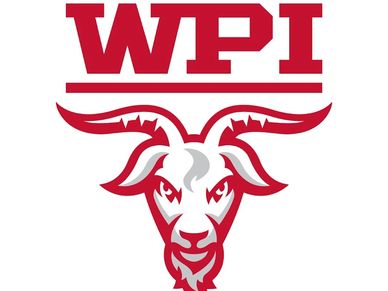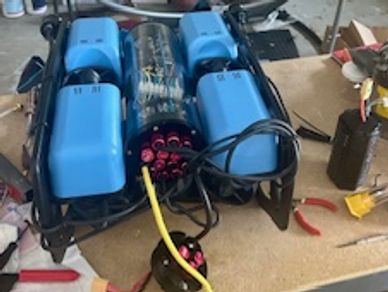Experience
COMING SOON! Engineering CO-OP- General Dynamics Electric Boat

I am currently working with communication and electrical systems at Electric Boat as of Fall 2025.
Designing and Building an ROV

For my Major Qualifying Project, my senior design project at WPI, I am leading a nine-person team in the design, build, and testing of a remotely operated underwater vehicle (ROV). As team lead, I coordinate project planning, oversee subsystem integration, and ensure that mechanical, electrical, and software teams are aligned throughout the design process. My personal focus is on the mechanical systems, where I am responsible for the ROV’s frame design, thruster mounts, and watertight enclosure integration. In addition, I am exploring biomimicry-inspired design features to minimize drag, specifically studying surface textures and forms from marine life that can improve hydrodynamic performance. This project is giving me the opportunity to combine leadership with technical problem-solving, while applying both mechanical and biomedical engineering principles to real-world marine robotics. More information to come soon!
BlueROV2 Rebuild
Mechanical Engineering Intern-Dyno Nobel

Outside of my internships, I have been working on restoring and upgrading a BlueROV2, a remotely operated underwater vehicle developed by Blue Robotics. When I received the vehicle, many of its parts were damaged or nonfunctional, so I took on the process of bringing it back to working condition. I 3D printed and repaired exterior components, rewired internal systems, and identified and replaced faulty parts to ensure reliable operation. Through this process, I’ve gained hands-on experience troubleshooting electronics and refining mechanical assemblies for underwater use, while also developing a deeper understanding of watertight housings and subsea systems. This project has allowed me to combine my background in mechanical design with my passion for marine robotics, giving me practical insight into how underwater vehicles are built, maintained, and optimized.
Mechanical Engineering Intern-Dyno Nobel
Mechanical Engineering Intern-Dyno Nobel

As a Mechanical Engineering Intern at Dyno Nobel, I worked on the design and fabrication of equipment used in explosives manufacturing, where engineers and technicians would bring me problems from the production floor to solve. One of the biggest challenges I addressed was with an extrusion machine that was extremely difficult to move for cleaning. I optimized the pintle mechanism by selecting better materials, adjusting the geometry, adding ergonomic handles, and incorporating guide pins to make movement smoother and safer. I also designed and fabricated an ergonomic stand for a hopper, integrating a pull-to-open chute that simplified operation and improved accessibility for plant workers. Beyond these major projects, I produced detailed CAD drawings to ASME Y14.5 standards and applied stress analysis and material selection to ensure reliable performance. This role gave me hands-on experience turning real manufacturing challenges into practical engineering solutions.
Use of AI with Algae Detection in Hong Kong

As part of my Interactive Qualifying Project (IQP) at WPI, I worked in Hong Kong on understanding the impact of algal blooms on local water systems and exploring ways to improve monitoring and detection. Sponsored by Dr. Chong Yee Ling at the Education University of Hong Kong, this initiative aims to tackle the significant issue of water pollution by identifying harmful algal blooms, which can severely impact ecosystems and human health. Our team collected physical water samples and image data from various sites across the region, assessing water quality and identifying algae species in both freshwater and coastal environments. We used a combination of microscopy, image analysis, and water chemistry testing to examine the extent of algal presence and the contributing environmental factors. Through this hands-on fieldwork, I gained a deeper understanding of the challenges algal blooms present to ecosystems, public health, and water management.
In addition to data collection, I helped design and build a website that serves as both an educational resource and a community science platform. The site allows local residents to upload their own algae photos to contribute to ongoing monitoring efforts. I also supported the early stages of training our AI model by helping to curate and label algae samples, laying the foundation for automated algae detection. Our project found that nutrient runoff and stagnant water conditions were major contributors to algal blooms in certain areas, highlighting the need for improved watershed management. This work combined environmental engineering, AI development, and community engagement — all aimed at building more resilient water systems and raising awareness of algae’s impact on daily life.
Mechanical Design for Optimizing Lactation

In Fall 2024, I began developing a breast pump insert designed to improve both comfort and milk expression efficiency for pumping mothers. After extensive research into lactation mechanics and user pain points, I created a biomimetic insert that better mimics the shape and angle of an infant’s mouth during nursing. Rather than redesigning an entire breast shield, the insert is designed to be universal — fitting into affordable, existing breast pump flanges. This allows for wider accessibility and eliminates the need for parents to purchase entirely new equipment.
Throughout the development process, I focused on user-centered design, prototyping with medical-grade silicone, and testing for comfort and function. The insert’s shape creates a more natural angle and contact point, aiming to reduce discomfort and optimize milk flow. I continued refining the design beyond the classroom with guidance from Professor Diana Alatalo at WPI, and as of February 2025, our invention has been officially filed for patent. The design is simple to manufacture, making it a cost-effective solution to enhance the pumping experience. I gained hands-on experience in CAD, prototyping, material testing, and iterative problem-solving, all while collaborating closely with a team to address real-world challenges. This project deepened my understanding of medical device design, the patenting process, and the importance of accessible innovation in women’s health.
Studying the Long-Term Effects of Fluoride on Bones

In the fall of 2024, I collaborated with a team in my Biomechanics Lab to investigate the mechanical effects of fluoride on bone structure. Using porcine (pig) bones, we designed a project to analyze how varying molar concentrations of fluoride impacted bone properties. This involved treating bones with different concentrations of sodium fluoride, conducting dissections, and performing flexure tests to measure stress, strain, and other mechanical properties.
Through this project, we aimed to explore the potential thresholds where fluoride might enhance or weaken bone strength, contributing to the ongoing debate about the benefits and risks of fluoride exposure. Working with the limitations of an in vitro study, including the scale of available equipment and timeline, I refined my skills in experimental design, mechanical testing, and data analysis. This experience deepened my understanding of biomechanical principles and their application to real-world health and material challenges.
Sensor Insertion for Catheters in Mechanical Thrombectomies
.jpg/:/cr=t:14.58%25,l:24.11%25,w:56.18%25,h:56.18%25/rs=w:388,h:388,cg:true,m)
During my time in the MedMaIn lab under Brianna Raphino, I worked on a project aimed at improving the precision of mechanical thrombectomies. The goal was to enable real-time visualization during procedures, allowing surgeons to determine whether blood clots were being effectively removed or if the catheter was too far from the target area, which could risk vein collapse. Working with microscale components presented unique challenges, requiring a high level of accuracy and innovation.
To address these challenges, I designed and built a device that inflates within the catheter to securely press a sensor against its wall. This mechanism ensures accurate data transmission without compromising the catheter's functionality. Through this project, I developed advanced skills in precision prototyping, materials design, and problem-solving in high-stakes medical applications. It also deepened my understanding of biomechanics and strengthened my ability to tackle complex engineering challenges.
Studying Obesity in the South Bronx

In the fall of 2022, during my freshman year at WPI, I participated in a research project for my Great Problems Seminar class, focusing on childhood obesity in low-income areas, with a specific emphasis on the South Bronx. Working in a team, we explored the challenges posed by obesity, particularly in neighborhoods where outdoor activity might be unsafe due to environmental and socioeconomic factors.
After conducting extensive research on the causes and impacts of childhood obesity, we proposed innovative solutions, including the use of virtual reality (VR) technology to promote indoor exercise in dangerous neighborhoods. This approach aimed to provide children with a safe and engaging way to stay active despite external challenges.
Our project culminated in a presentation at a campus-wide fair, where we showcased our findings and solutions. We were honored to receive the Judges’ Choice Award for our creativity and impact. Through this experience, I enhanced my teamwork abilities, problem-solving skills, and research capabilities, while learning how interdisciplinary approaches can address complex societal issues.
Researching Aquariums in Japan
Researching Aquariums in Japan

During the summer of 2024, I had the incredible opportunity to conduct research on aquariums throughout Japan as part of a WPI program. This project involved traveling to various locations to study the role of aquariums in public education, marine conservation, and cultural engagement. I analyzed exhibit designs, the incorporation of technology, and the ways aquariums communicated environmental awareness to diverse audiences.
One key focus of my research was evaluating how family-friendly attractions like the Kyoto Aquarium contributed to fostering an appreciation for marine life and sustainable practices. By observing and documenting these spaces, I gained valuable insights into the intersection of education, culture, and technology.
This experience enhanced my analytical and observational skills while deepening my understanding of how engineering and design can create impactful educational tools. It also reinforced my passion for marine conservation and the critical role that innovative public spaces play in inspiring environmental stewardship.
Phoebe Underwater
Cookie monster here.
They make me use cookies to analyze website traffic and optimize your website experience. By accepting the use of cookies, your data will be aggregated with all other user data.